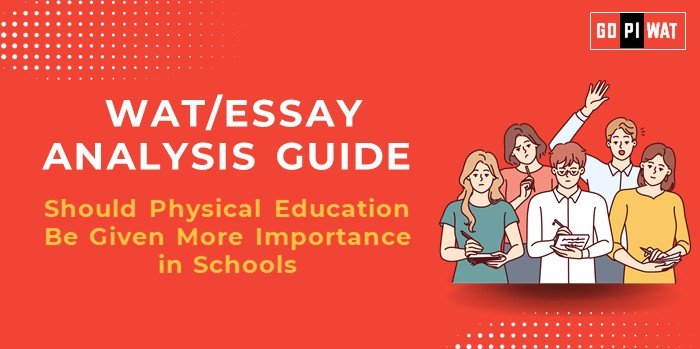📋 Written Ability Test (WAT) Analysis Guide: Should Physical Education Be Given More Importance in Schools?
🌟 Understanding the Importance of Physical Education
This topic intersects with themes of public health, educational policy, and mental wellness. For B-school applicants, addressing the role of PE in schools relates to broader organizational strategies that emphasize holistic development, positively impacting long-term productivity and well-being.
📝 Effective Planning and Writing
- ⏳ Time Allocation:
- Planning: 5 minutes
- Writing: 15 minutes
- Review: 5 minutes
- 💡 Preparation Tips:
- Gather key statistics on health, academic benefits, and successful global models.
- Outline stakeholders and their roles for a balanced perspective.
🚀 Introduction Techniques for Essays
- ⚖️ Contrast Approach: “While academic success remains central, rising child obesity and mental health issues make a strong case for greater PE inclusion.”
- 🔧 Solution-Based Approach: “Increased focus on PE could address the alarming rates of physical inactivity and boost both mental and academic performance.”
📚 Structuring the Essay Body
🏆 Achievements
- 🌍 Global Success: Countries like Japan and Finland show how structured PE programs improve overall student health and academic outcomes.
- 📈 Improved Academic Performance: Studies reveal that physically active students demonstrate better attention spans and cognitive function.
⚠️ Challenges
- 💰 Funding Issues: Many schools lack the necessary infrastructure, resources, and trained instructors for comprehensive PE programs.
- 📚 Academic Competition: Pressure to excel in core subjects often sidelines PE.
- 🌐 Cultural Barriers: In some regions, there’s a perception that PE is less valuable than academic subjects.
🔮 Future Outlook
- 🏛️ Policy Reforms: Encourage mandatory PE with government support and funding.
- 🤝 Public-Private Partnerships: Collaborate with sports organizations to provide quality programs and training.
- 💬 Holistic Benefits: Promote awareness of PE’s role in improving physical health, mental wellness, and academic success.
💡 Concluding Effectively
- ⚖️ Balanced Perspective: “Though academics remain crucial, a structured approach to PE in schools can improve both physical health and mental well-being, fostering all-round development.”
- 🌍 Global Comparison: “Countries that prioritize PE, like Finland, demonstrate how integrating physical activity within the school day can complement academic rigor and personal growth.”
📊 Analyzing Successes and Shortcomings
- ✅ Key Achievements: PE programs improve health outcomes, reduce stress, and enhance academic performance.
- ⚠️ Ongoing Challenges: Resource shortages, cultural biases, and a lack of time due to academic pressure.
- 🌐 Global Context: Regions like Scandinavia successfully balance PE and academics, highlighting the feasibility of expanded PE programs.
🔧 Recommendations for Sustainable Progress
- 🏛️ Policy Initiatives: Government funding and mandatory PE integration into school curricula.
- 🤝 Community Engagement: Partner with sports organizations and fitness experts to enhance PE quality.
- 🌱 Cultural Shift: Promote awareness of PE’s benefits for physical health, mental wellness, and academic success.
📝 Sample Short Essays
1️⃣ Balanced Perspective
“Physical education is essential for student development, providing benefits that complement academic learning. Increasing PE’s presence in schools could foster healthier, more engaged students without compromising academic success.”
2️⃣ Solution-Oriented
“To tackle rising child obesity and mental health issues, schools should prioritize PE. Structured activity can improve physical health, attention, and cognitive function, which positively impacts academics.”
3️⃣ Global Comparison
“Countries like Finland demonstrate how integrating PE within the school day promotes healthier lifestyles without sacrificing academic rigor. Adopting this model could transform education into a more holistic approach for well-being.”
🏆 Final Insights
For B-school applicants, recognizing the importance of physical education emphasizes a holistic approach to leadership and workforce productivity. Addressing this topic demonstrates an understanding of policy implementation, organizational well-being, and long-term societal impacts.


